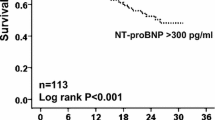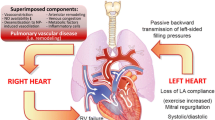Abstract
Purpose
Left ventricular hypertrophy (LVH) is a significant cardiac risk factor, associated with increased mortality. The impact of LVH on mortality in chronic obstructive pulmonary disease (COPD) is unknown. We evaluated the impact of LVH on mortality in COPD patients by measurement of left ventricular dimensions by echocardiography.
Methods
Retrospective cohort study utilizing a NHS database of COPD patients (TARDIS), in Tayside, Scotland (2001–2010), linked with databases regarding echocardiograms, pharmacy prescription, and the General Register Office for Scotland death registry. Cox proportional hazard regression was used to determine hazard ratios for mortality and hospital admissions based upon left ventricular mass index (LVMI) and left ventricular internal diastolic diameter after correction for all available influential covariates. Increased LVIDd was defined as >5.3 cm (female) and >5.9 cm (male). LVH was defined as an LVMI of >95 g/m2 (female) and >115 g/m2 (male).
Results
617 patients were included for analysis. Mean (SD) age at diagnosis, 70 (9); mean FEV1 % (SD), 60.6 (19.3); mean resting SaO2 % (SD), 92.7 (10). Mean follow-up 4.5 years. Increased LVIDd was not associated with increased mortality, χ 2= 0.767, p = 0.381. Increased LVMI was associated with a significant increased risk of mortality, χ 2 = 5.447, p = 0.02 with an adjusted HR (95 % CI) of 1.542 (1.068–2.228), p = 0.021.
Conclusions
The presence of LVH, demonstrated by elevated left ventricular mass index is associated with a significantly increased risk of mortality in COPD patients. Therapeutic interventions are required to address this important modifiable risk factor in COPD patients.





Similar content being viewed by others
Abbreviations
- COPD:
-
Chronic obstructive pulmonary disease
- FEV1 :
-
Forced expiratory volume in one second
- GOLD:
-
Global initiative for obstructive lung disease
- HIC:
-
Health Informatics Centre
- IVSTd:
-
Inter-ventricular septum thickness in diastole
- LVIDd:
-
Left ventricular internal diastolic diameter
- LVH:
-
Left ventricular hypertrophy
- LVMI:
-
Left ventricular mass index
- NHS:
-
National health service
- TARDIS:
-
Tayside respiratory disease information system
- PWTd:
-
Posterior wall thickness in diastole
References
Sin DD, Man SF (2003) Why are patients with chronic obstructive pulmonary disease at increased risk of cardiovascular diseases? The potential role of systemic inflammation in chronic obstructive pulmonary disease. Circulation 107:1514–1519
Hurst JR, Vestbo J, Anzueto A et al (2010) Susceptibility to exacerbation in chronic obstructive pulmonary disease. N Engl J Med 363:1128–1138
McAllister DA, Maclay JD, Mills NL et al (2012) Diagnosis of myocardial infarction following hospitalisation for exacerbation of COPD. Eur Respir J 39:1097–1103
Report of the Medical Research Council Working Party (1981) Long term domiciliary oxygen therapy in chronic hypoxic cor pulmonale complicating chronic bronchitis and emphysema. Lancet 1(8222):681–686
Nocturnal Oxygen Therapy Trial Group (1980) Continuous or nocturnal oxygen therapy in hypoxemic chronic obstructive lung disease: a clinical trial. Ann Intern Med 93(3):391–398
Ang DS, Pringle SD, Struthers AD (2007) The cardiovascular risk factor, left ventricular hypertrophy, is highly prevalent in stable, treated angina pectoris. Am J Hypertens 20:1029–1035
Gosse P (2005) Left ventricular hypertrophy as a predictor of cardiovascular risk. J Hypertens Suppl 23:S27–S33
Liao Y, Cooper RS, McGee DL et al (1995) The relative effects of left ventricular hypertrophy, coronary artery disease, and ventricular dysfunction on survival among black adults. JAMA 273:1592–1597
Benjamin EJ, D’Agostino RB, Belanger AJ et al (1995) Left atrial size and the risk of stroke and death. The Framingham Heart Study. Circulation 92:835–841
Fuso L, Incalzi RA, Pistelli R et al (1995) Predicting mortality of patients hospitalized for acutely exacerbated chronic obstructive pulmonary disease. Am J Med 98:272–277
Short P, Chalmers J, Akram A et al (2012) Impact of tachycardia and new onset atrial fibrillation in acute exacerbations of COPD. Thorax 67:A158–A159
Jensen MT, Marott JL, Lange P et al (2013) Resting heart rate is a predictor of mortality in COPD. Eur Respir J 42:341–349
Anderson WJ, Lipworth BJ, Rekhraj S et al (2013) Left ventricular hypertrophy in COPD without hypoxemia: the elephant in the room? Chest 143:91–97
Schembri S, Anderson W, Morant S et al (2009) A predictive model of hospitalisation and death from chronic obstructive pulmonary disease. Respir Med 103:1461–1467
Short PM, Lipworth SI, Elder DH et al (2011) Effect of beta blockers in treatment of chronic obstructive pulmonary disease: a retrospective cohort study. BMJ 342:d2549
Devereux RB, Alonso DR, Lutas EM et al (1986) Echocardiographic assessment of left ventricular hypertrophy: comparison to necropsy findings. Am J Cardiol 57:450–458
Foppa M, Duncan BB, Rohde LE (2005) Echocardiography-based left ventricular mass estimation. How should we define hypertrophy? Cardiovasc Ultrasound 3:17
Lang RM, Bierig M, Devereux RB et al (2006) Recommendations for chamber quantification. Eur J Echocardiogr 7:79–108
Global strategy for the diagnosis, management, and prevention of chronic obstructive pulmonary disease. Executive Summary. (Updated 2009) Global Initiative for Chronic Obstructive Lung Disease. http://www.goldcopd.com. Accessed 01 June 2014
Chang CL, Robinson SC, Mills GD et al (2011) Biochemical markers of cardiac dysfunction predict mortality in acute exacerbations of COPD. Thorax 66:764–768
Smith BM, Kawut SM, Bluemke DA et al (2013) Pulmonary hyperinflation and left ventricular mass: the multi-ethnic study of atherosclerosis COPD Study. Circulation 127:1503–1511 1511e1501–1506
Devereux RB, Wachtell K, Gerdts E et al (2004) Prognostic significance of left ventricular mass change during treatment of hypertension. JAMA 292:2350–2356
Okin PM, Devereux RB, Gerdts E et al (2006) Impact of diabetes mellitus on regression of electrocardiographic left ventricular hypertrophy and the prediction of outcome during antihypertensive therapy: the Losartan Intervention For Endpoint (LIFE) Reduction in Hypertension Study. Circulation 113:1588–1596
Rekhraj S, Gandy SJ, Szwejkowski BR et al (2013) High-dose allopurinol reduces left ventricular mass in patients with ischemic heart disease. J Am Coll Cardiol 61:926–932
Szwejkowski BR, Gandy SJ, Rekhraj S et al (2013) Allopurinol reduces left ventricular mass in patients with type 2 diabetes and left ventricular hypertrophy. J Am Coll Cardiol 62:2284–2293
Barr RG, Bluemke DA, Ahmed FS et al (2010) Percent emphysema, airflow obstruction, and impaired left ventricular filling. N Engl J Med 362:217–227
Dallari R, Barozzi G, Pinelli G et al (1994) Predictors of survival in subjects with chronic obstructive pulmonary disease treated with long-term oxygen therapy. Respiration 61:8–13
Delgado-Rodriguez M, Llorca J (2004) Bias. J Epidemiol Community Health 58:635–641
Acknowledgments
This study was funded by University of Dundee.
Conflict of interest
None.
Author information
Authors and Affiliations
Corresponding author
Rights and permissions
About this article
Cite this article
Short, P.M., Anderson, W.J., Elder, D.H.J. et al. Impact of Left Ventricular Hypertrophy on Survival in Chronic Obstructive Pulmonary Disease. Lung 193, 487–495 (2015). https://doi.org/10.1007/s00408-015-9724-8
Received:
Accepted:
Published:
Issue Date:
DOI: https://doi.org/10.1007/s00408-015-9724-8




